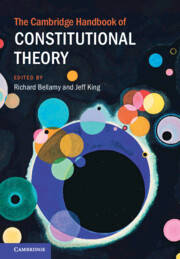Book contents
- The Cambridge Handbook of Constitutional Theory
- The Cambridge Handbook of Constitutional Theory
- Copyright page
- Contents
- Figures
- Contributors
- Frontispiece
- Preface and Acknowledgements
- 1 Introduction
- Part I Values
- Part II Modalities
- 10 Impartiality
- 11 Constitutional Legitimacy
- 12 Sovereignty
- 13 Constituent Power
- 14 Representation
- 15 Deliberation
- 16 Opposition
- 17 The Separation of Powers
- 18 The Rule of Law
- 19 Constitutional Conventions
- 20 Secularism
- 21 Constitutional Review
- 22 Constitutional Interpretation
- 23 Proportionality
- 24 Civil Disobedience
- 25 Constitutional Entrenchment
- 26 Emergency Powers
- 27 Regulation
- 28 Cost–Benefit Analysis
- 29 Revolution
- Part III Institutions
- Part IV Challenges for Constitutional Democracy
- Bibliography
- Index
- References
16 - Opposition
from Part II - Modalities
Published online by Cambridge University Press: 27 March 2025
- The Cambridge Handbook of Constitutional Theory
- The Cambridge Handbook of Constitutional Theory
- Copyright page
- Contents
- Figures
- Contributors
- Frontispiece
- Preface and Acknowledgements
- 1 Introduction
- Part I Values
- Part II Modalities
- 10 Impartiality
- 11 Constitutional Legitimacy
- 12 Sovereignty
- 13 Constituent Power
- 14 Representation
- 15 Deliberation
- 16 Opposition
- 17 The Separation of Powers
- 18 The Rule of Law
- 19 Constitutional Conventions
- 20 Secularism
- 21 Constitutional Review
- 22 Constitutional Interpretation
- 23 Proportionality
- 24 Civil Disobedience
- 25 Constitutional Entrenchment
- 26 Emergency Powers
- 27 Regulation
- 28 Cost–Benefit Analysis
- 29 Revolution
- Part III Institutions
- Part IV Challenges for Constitutional Democracy
- Bibliography
- Index
- References
Summary
This chapter explores the idea of opposition. One may make known one’s opposition to specific measures and one may make known one’s opposition to those who hold the office of government. While opposition to those who rule may flourish only in constitutional arrangements that contemplate changes in government, the freedom to make known opposition to measures may obtain and flourish even absent such arrangements. These two different modalities of opposition – to measures and to governments – draw on a reciprocal understanding that those who oppose and those who rule are both committed to the public good. Depending on the design of its system of government, a constitution may enable or empower opposition, with the parliamentary form of government differing in important respects from the presidential. Some constitutional arrangements and proposals award to opposition members in legislatures and elsewhere some degree of authority in exercising the office of government. Whatever the merits of such coalition or consensus arrangements and proposals, they change the function of opposition, for when those who oppose begin to govern, a version of the question quis custodiet ipsos custodes (who guards the guardians) arises: who stands in opposition to the opposition?
Keywords
- Type
- Chapter
- Information
- The Cambridge Handbook of Constitutional Theory , pp. 262 - 278Publisher: Cambridge University PressPrint publication year: 2025

